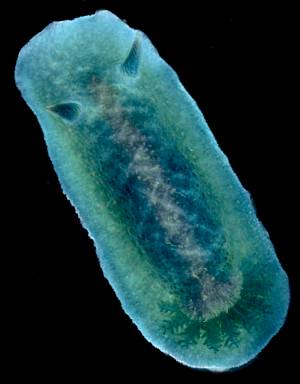
Doriopsis pecten
(Collingwood, 1881)
Order: NUDIBRANCHIA
Suborder: DORIDINA
Superfamily: EUDORIDOIDEA
Family: Dorididae
DISTRIBUTION
Indo-West Pacific
PHOTO
Upper & Lower Right: Koumac Beach (=Baie de Ouanap), near Koumac, New Caledonia, 27 October 1993, 7mm long alive (blue), AM C200674.
Lower Left: Îlot Freycinet, Nouméa, 1m, 23 October 1988, AM C156676, 11mm long alive, on deep blue sponge. Photos: Bill Rudman
Species of Doriopsis are characterised by the arrangement of the gills in a transverse line across the back rather than in the typical dorid circle. There is a dorsal flap covering the gill opening. D. pecten has small rounded tubercles over the mantle. The mantle is blue, sometimes so dark are to appear almost black, and in the raised central region is usually paler, almost translucent in colour, with a criss-cross pattern caused by the underlying spicules in the skin. It is often found feeding on a deep blue sponge, Terpios.
Specimens of Doriopsis are either deep blue, green or yellow and there has been considerable confusion in the literature concerning how many species there are in the genus. At one extreme 4 species, one each of green and blue and two of yellow have been suggested, while at the other extreme only one variably coloured species has been proposed.
Biological observations from throughout the Pacific suggest that there are at least two species, one yellow or green and one deep blue. It is also possible that the yellow New Zealand species, Doriopsis flabellifera Cheeseman, 1881, is a third valid species. The earliest name for the yellow/green species is D. granulosa and for the blue, D. pecten. Reports from Hawaii (Kay & Young, 1969; Bertsch & Johnson,1981), Japan (Hamatani, 1961, Baba & Hamatani, 1961), and the central Pacific (Young, 1967; Johnson, 1981) show that D. pecten feeds exclusively on a deep blue sponge Terpios, and D. granulosa on a yellow or orange sponge, identified by Young (1967) as Prianos phlox de Laubenfels, 1954. The eggs of D. granulosa are reported to be yellow, while those of D. pecten are cream, and the egg ribbon of D. granulosa is about four times as wide as that of D. pecten. The green 'species' or 'form' has often been named Doriopsis viridis Pease, 1861.
Reference:
• Baba, K. & Hamatani, I., 1961. On two new species of Doriopsis (syn. Ctenodoris) from Japan (Nudibranchia - Dorididae). Publications of the Seto Marine Biological Laboratory, 9: 63-65.
• Bertsch, H. & Johnson, S., 1981. Hawaiian Nudibranchs. Honolulu: Oriental Publishing Co.
• Collingwood, C. (1881). On some new species of nudibranchiate mollusca from the Eastern Seas. Transactions of the Linnean Society, London, Zoology, 2: 123-140, Pls 9-10.
• Hamatani, I., 1961. Notes on veligers of Japanese opisthobranchs (4). Publications of the Seto Marine Biological Laboratory, 9(2): 353-361.
• Johnson, S., 1981. Blue camouflage in a nudibranch. Hawaiian Shell News, 29(6): 14.
• Kay, E.A. & Young, D.K., 1969. The Doridacea (Opisthobranchia: Mollusca) of the Hawaiian Islands. Pacific Science, 23: 172-231.
• Pease, W.H. (1860). Descriptions of new species of mollusca from the Sandwich Islands. Proceedings of the Zoological Society of London, 28: 18-37.
• Young, D.K., 1967. New records of Nudibranchia from the Central and West-Central Pacific with a description of a new species. The Veliger, 10: 159-173.
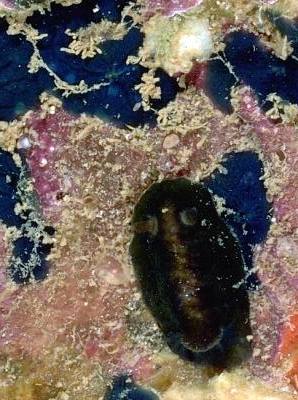
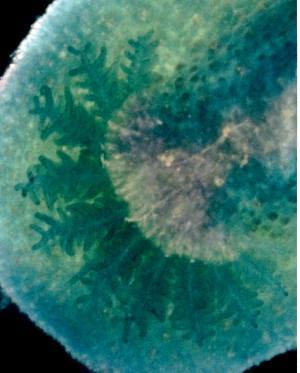
Rudman, W.B., 2003 (March 6) Doriopsis pecten (Collingwood, 1881). [In] Sea Slug Forum. Australian Museum, Sydney. Available from http://www.seaslugforum.net/find/doripect
Related messages
Dendrodoris sp. or Doriopsis granulosa ?
January 30, 2006
From: Yukari Tani
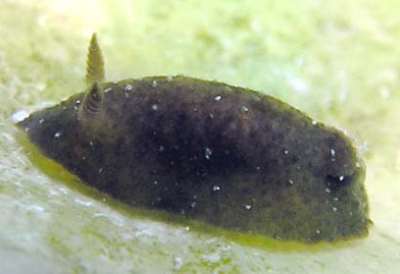
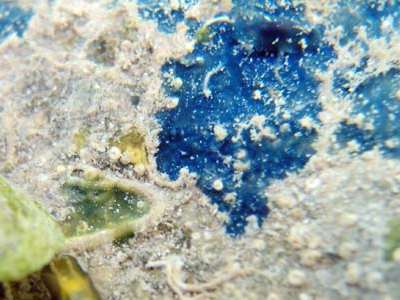
Dear Dr.Bill,
I could not show you this Sea slug's gills because we did not see them, yet.
We always can find it in the neighborhood of Doriopsis pecten (maybe).
Locality: Saipan, Northern Mariana Islands, Pacific Ocean. Eelgrass Beds. Depth: 1.5 m. Length: 5 mm. 4 January 2006. on the dead coral across blue sponge. Photographer: Yukari Tani
Would you tell me which one this is, please ?
Best regards,
Gon
dswith@isletwind.com
2006 (Jan 30) Dendrodoris sp. or Doriopsis granulosa ?. [Message in] Sea Slug Forum. Australian Museum, Sydney. Available from http://www.seaslugforum.net/find/15626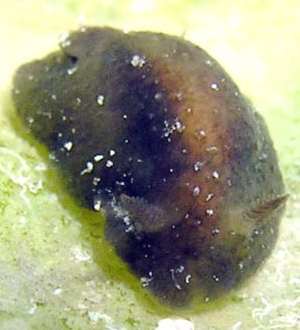
Dear Gon,
If it is on this deep blue sponge, Terpios, then I am pretty sure it is Doriopsis pecten. Even if you can't see the fan-shaped gills, in your photo alongside the flat shelf-like flap over the gill pocket is clearly visible - and that is only found in species of Doriopsis. If look at the Fact Sheets on D. pecten and D. granulosa you will see that both species can have a greenish brown form. D. granulosa is usually found on an orange-yellow sponge and appears to have a different sized and coloured egg ribbon.
Best wishes,
Bill Rudman
Doriopsis pecten and egg ribbon from Japan
March 10, 2003
From: Nishina Masayoshi
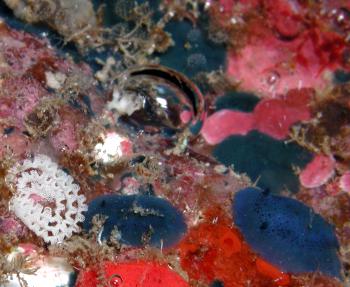
Dear Bill,
Doriopsis pecten is always found around is blue food sponge in Hachijo Island, Japan. The body color of D. pecten seems to be a form of camouflage when it is near the the blue sponge as you can see in the upper photo. When I am looking for this species I try to find the egg mass first and then I know where the adults are likely to be. I have attached an image of D. pecten with their egg mass.
Doriopsis viridis was introduced by Baba's paper(1961) as Japanese scientific name "Ao-Kushiera-umiushi". Baba's description of D. viridis almost completely fitted the features of D. pecten, and several years later, Ao-Kushiera-umiushi's scientific name had changed to D. pecten. I have also attached J. Imamoto's image. I suspect this is green form of D. pecten.
Photos: Upper Right, Centre Left, Centre Right: 7 Sep. 2002 on Hachijo Island. Tokyo, Japan. Length: 10mm. Photo: M. Nishina
Lower Right: 25 Nov. 2001. Shimoda, Izu Peninsula, Japan. Length: 9mm. Photo: Jun Imamoto
Best Regards,
Nishina Masayoshi
nishina@wips.co.jp
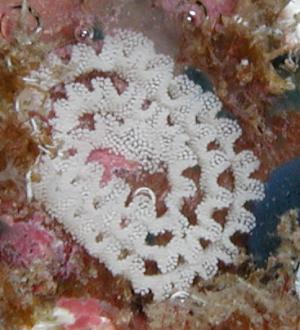
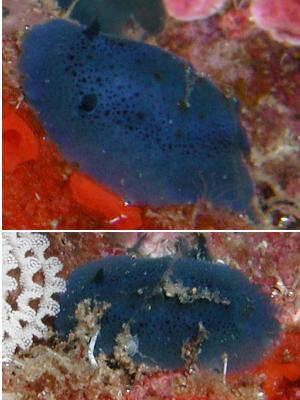
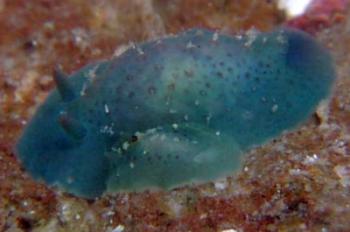
Dear Nishina,
Thanks for this photo showing the blue sponge and the egg ribbon. It is interesting to see just how different it appears to be from that of D. granulosa.
I have attached J. Imamoto's image of a greenish animal alongside. Concerning the name Doriopsis viridis. It was first introduced by Pease 1861 for animals from Hawaii. Since both D. pecten and D. granulosa have greenish colour forms there has been a lot of confusion over just what Pease was describing. This is a good example of how important it can be to have natural history information, such as shape of egg ribbons and food, when describing new species.
Best wishes,
Bill Rudman
Doriopsis pecten from nthn New South Wales
March 7, 2003
From: Bill Rudman

Here is a photo of Doriopsis pecten from northern New South Wales in eastern Australia. The tubercles on the mantle are smaller and harder than in D. granulosa. In the midregion of the mantle a criss-cross pattern of spicules in skin could be seen in the live animal.
Photo: Arrawarra, Coffs Harbour, New South Wales, 13 March 1982, 3 specimens found - 10,7,6mm long alive. AM C133003. Photo: Bill Rudman
Best wishes,
Bill Rudman.
Doriopsis pecten and food sponge
March 7, 2003
From: Bill Rudman
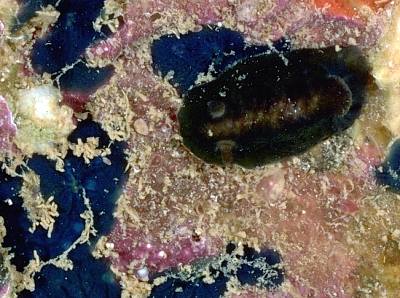

Here is a photo of Doriopsis pecten and its dark blue food sponge Terpios from New Caledonia. This animal is quite dark coloured but the characteristic translucent central band is clearly visible. The lower photo is slightly over exposed to show some of the detail.
Photo: Îlot Freycinet, Nouméa, 1m, 23 October 1988, AM C156676, 11 long alive, on deep blue sponge, Photo: Bill Rudman
Best wishes,
Bill Rudman.
Doriopsis pecten from New Caledonia
March 7, 2003
From: Bill Rudman
Here is a photo of a typical Doriopsis pecten from New Caledonia. The criss-cross pattern of spicules is clearly seen in the dorsal midline. The lower photo shows the characteristic posteriorly facing gills arranged in a horizontal fan-shape. The dorsal flap covering the gill opening is somewhat wider in this species than in Doriopsis granulosa.
Photo: Lower Left - close-up of gills. Koumac Beach (=Baie de Ouanap), near Koumac, New Caledonia, 20°34'S, 164°16'E, Mixed soft and hard substrate, grassbeds, algae, 27 October 1993, 7mm long alive, AM C200674. Photos: Bill Rudman.
Best wishes,
Bill Rudman


small blue dorid from Japan
January 3, 2000
From: Satoru Hori
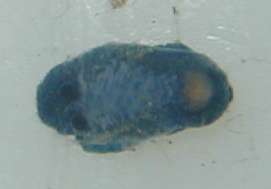
Dear Bill
I found this seaslug at Miura peninshula,
Yokosuka city, Japan.
This slug's image is located on the following URL:
http://www.asahi-net.or.jp/~IK8S-HR/image/umiushi/umiphoto/u_blue2.jpg
It was on the rock coverd with seaweed in the rocky beach on 29th Dec 1999.
Length :5mm, Depth: intertidal
Could you identify this?
Satoru
ik8s-hr@asahi-net.or.jp
Hori, S., 2000 (Jan 3) small blue dorid from Japan. [Message in] Sea Slug Forum. Australian Museum, Sydney. Available from http://www.seaslugforum.net/find/1720Dear Satoru,
I think your animal is Doriopsis pecten. It is similar in shape to Doriopsis granulosa and I will put some pictures of it on the Forum when I return to Australia in two weeks.
One good way of identifying species of Doriopsis from their external appearance is to look at the gills. In Doriopsis they do not form a circle like in most dorids but are arranged in a transverse line across the back of the animal, each gill pointing backwards.
Best wishes,
Bill Rudman.
